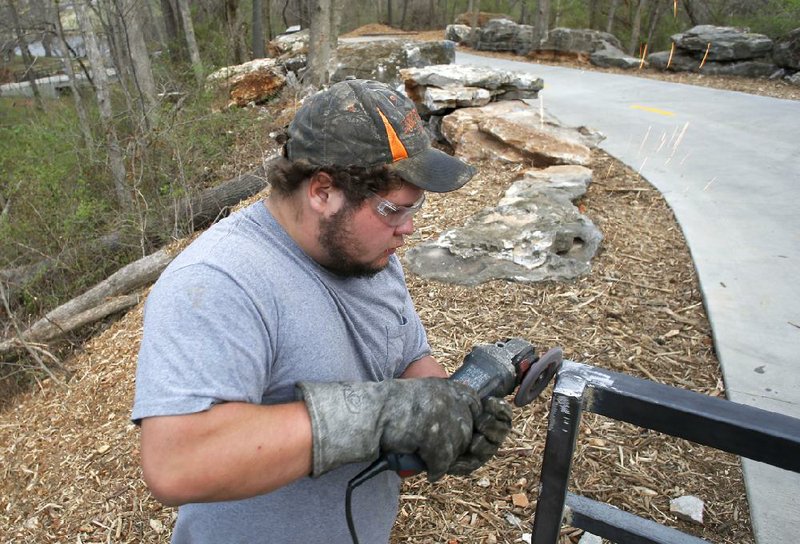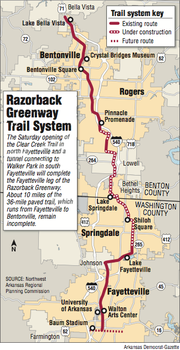The Razorback Greenway, a 36-mile paved trail for pedestrians and bicyclists, is on schedule to be completed by the end of the year, a representative of the Northwest Arkansas Regional Planning Commission said Thursday.
John McLarty, assistant director and transportation planner for the commission, said all but about 10 miles of the Greenway, which stretches from Walker Park in south Fayetteville to Lake Bella Vista in Bentonville, will be complete as of Saturday.
Two planned ribbon-cutting ceremonies Saturday will officially open Fayetteville’s stretch of the trail.
The 3-mile section dubbed the Clear Creek Trail will connect Lake Fayetteville to the north-south “spine” of the Greenway.
Also opening Saturday will be a tunnel that will connect the southern end of the Frisco Trail in south Fayetteville with Walker Park by passing under Martin Luther King Jr. Boulevard.
Patsy Christie, director of planning and community development for Springdale, said construction on several portions of the trail in Springdale is underway or about to begin.
The deadline for construction bids on the final section of the Greenway, which is in Lowell, is April 15, McLarty said.
He said the project is coming in “right at” its original projected cost of $38 million.
Design and construction, along with right of way acquisition of land, was primarily funded through two sources: a $15 million federal Transportation Investment Generating Economic Recovery grant, also known as a “Tiger II” grant, and a $15 million grant from the Walton Family Foundation. An additional $8 million was raised through private and public donations.
Christie and McLarty said the Springdale portion of the Greenway has lagged behind stretches in neighboring cities because the Springdale portion relies almost exclusively on federal dollars.
“It’s the largest section of the whole trail that was funded with federal dollars,” Christie said.
“All of it going through Springdale was part of the Tiger program. It takes longer when you use federal dollars than when you don’t.”
Once complete, the Razorback Greenway will be the longest system of paved, interconnected trails in Arkansas, said Misty Murphy, regional trails coordinator for the Northwest Arkansas Council.
The trail runs through many regional highlights, including a wetlands area south of Bentonville High School and public art installations near the Fayetteville Public Library.
Murphy said several cities along the trail have recently solicited art submissions from the public to be placed along the trail.
Murphy said Bentonville and Fayetteville have bicycle police already patrolling their sections of the trailand have installed extensive lighting.
Other cities are considering adding such safety features.
There are plans to install distance markers every tenth of a mile along the Greenway so users can readily communicate their locations to 911 dispatchers in case of an emergency, Murphy said.
“A lot of spaces along the Greenway are through trafficked areas, so you’re never far from civilization, even though you might feel like it,” Murphy said.
McLarty said feedback from pedestrians using the trail has been overwhelmingly positive and that even the complaints are signs that people are using the trail system.
“We’re getting questions and comments like, ‘We need more restrooms, more parking access points,’” McLarty said.
“So the comments are based on usage.”
McLarty said the commission’s original proposal included six trail-heads with parking along the Greenway, but the available federal funding fell about $8 million short of the estimated cost, so the trail-heads were removed from the plan.
Since the plan was initiated in 2010, however, cities along the route have built trail-heads using a combination of city and federal funds, McLarty said.
In addition to providing an alternative transportation corridor through the bigger cities of Northwest Arkansas, the Razorback Greenway ties in with dozens of smaller trails that branch off into neighborhoods and downtown businesses.
The Fayetteville Alternative Transportation & Trails Master Plan lists 24 existing trails and more than 50 proposed trails, which will become increasingly accessible from the Greenway over the coming years, said Fayetteville trails coordinator Matt Mihalevich.
McLarty said the philosophy around the Razorback Greenway is not just to provide new paths for transportation, but also to encourage walking and bicycling as a part of people’s daily routines.
“They could actually have another alternative to get to work, to school, to a recreational area, by using a bicycle or on foot,” McLarty said.
“So that’s a good thing that can take some cars off the road. I have a personal interest in seeing children using the trail system to get to school. It’s a great thing to get the kids outdoors and making it safe to be active.
“My little speech I give people is, when I was a kid back in Lubbock, Texas, in the ’50s, armies of kids rode their bikes to school. We would be embarrassed to have our parent take us to school in sixth grade. But it was a little safer, there weren’t as many cars on the road. We’ve increased car congestion, but we haven’t really kept up with bicycle and pedestrian infrastructure, so it’s a little out of balance. We need to make it safe again, so a child can ride a bike or walk to school.”
Arkansas, Pages 10 on 04/07/2014

